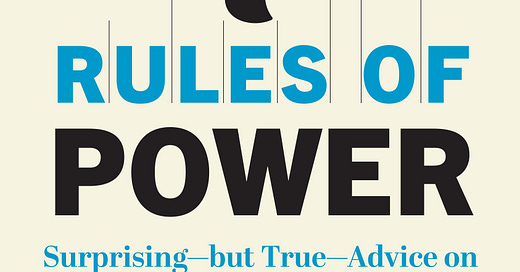Reading about power usually feels like reading about Cold War spies or watching Jack Sparrow commandeer a ship1. It’s exciting and I can live vicariously, imagining myself in a world of espionage and intrigue. Reading Machiavelli or The 48 Laws of Power is fun, but I have never actually found it useful.
I just finished a book about power that felt a lot less fictional. This excellent article recommended 7 Rules of Power as a way for tech managers to learn to build influence in their organization. The book’s author, Jeffrey Pfeffer, is a professor at Stanford GSB and apparently his course is among the most popular at the business school.
This book feels more practical because Pfeffer includes case studies of his students, who are doing things that are impressive but relatable: competing for a middle management job at Google or networking their way into a dinner with Martha Stewart at Sundance (emphasized bc it seemed fun).
The book offers a fairly cynical take on power, asserting that modern theories about authenticity and vulnerability in leadership are wildly overblown, and that in reality power tends to be won through less feel-good tactics. Pfeffer believes that well-intentioned people must embrace these tactics to build and wield power if they want to make positive change in the world.
These are the 7 rules, and I’d encourage you to check out the book if they seem interesting:
1) Get out of your own way.
2) Break the rules.
3) Show up in powerful fashion.
4) Create a powerful brand.
5) Network relentlessly.
6) Use your power.
7) Understand that once you have acquired power, what you did to get it will be forgiven, forgotten, or both.7 Rules of Power by Jeffrey Pfeffer
Finding a seam
“Just hire them both,” our CTO slacked me when I asked him his opinion on two candidates I’d just interviewed. I blinked at the screen and shrugged. Thanks to luck and a tech sector awash in cheap capital, I’d found myself building out a team of 6 data analysts, having never managed anyone before.
I had started at the company a year prior as an analyst embedded in a group of VCs. I would use our company’s proprietary data (which the Product team produced) to help them find and diligence potential CPG investments (this didn’t work very well; you can read about that here). I did not have much power at all; I mostly took orders from the investors.
Then by chance, some org changes reshuffled teams and I began reporting into the Product team which managed the technology behind the company’s database. The Product team was building products for investors but didn’t understand them very well, and so because I had worked directly with the investors I was operating at a seam between these two groups. Within a few months, I got a big raise and was hiring a team. I gained some power.
I didn’t orchestrate this — I just happened to be positioned at a “seam” in the organization, between two teams that needed to interact but did not really understand each other.
Under his “network relentlessly” rule, Pfeffer emphasizes the importance of placing yourself at the center of a network, what he calls a “high leverage” position. This is the method of gaining power that I experienced, and it also seems “easiest” to me, because you don’t really have to change how you act, you just have to change your focus and where you are positioning yourself.
I have seen it work in lots of cases:
A friend who was a junior associate at a law firm and happened to have done a bunch of research on crypto in 2018; she quickly became the firm’s expert on crypto and accelerated her career by operating at the seam between clients interested in crypto and lawyers who had no technical background
A writer who bridges more than one industry can become a focal point for all of them; a good example is Matt Levine who was both a lawyer and a banker and now writes at the seam between these worlds to a huge audience
Martha Stewart (who must be on my mind since I just watched the new documentary) worked on Wall Street and excelled in its elite subcultures. But she had the vision to sell this lifestyle to a mass market; she found a seam between moneyed Connecticut and middle class housemakers who wanted more beauty in their lives.
Product Managers exist at the seam of engineering, design, and business functions and are often among the most powerful people at tech companies; see Sundar Pichai who rose through the ranks as a PM at Google before becoming its CEO
What should you do about it?
As I have discussed, I’m a Loser, and am not particularly power-hungry. But it feels much better to have some power at work than none at all; you feel more secure and can have more control over your life.
So, I’d advise you to look for seams where you operate. One good thing about technology accelerating at a terrifying rate means there are new seams being created everywhere. A couple of examples:
Big Tech is moving into nuclear energy to power data centers; if you work in tech and are interested in energy / climate, there will be a seam between software people and people who understand energy generation.
I tell college students who are looking for jobs that every company now is trying to understand how to use generative AI, and they can position themselves at the seam between legacy business practices and generative AI
These are big macro seams, but there are undoubtedly smaller seams in whatever your work or interests are, and learning a lot about the groups on each side and positioning yourself at the seam will help you become more powerful.
The first Pirates of the Caribbean might be the movie I’ve watched most in my life




![7 Rules of Power: Surprising--but True--Advice on How to Get Things Done and Advance Your Career [Book] 7 Rules of Power: Surprising--but True--Advice on How to Get Things Done and Advance Your Career [Book]](https://substackcdn.com/image/fetch/$s_!JBzR!,w_1456,c_limit,f_auto,q_auto:good,fl_progressive:steep/https%3A%2F%2Fsubstack-post-media.s3.amazonaws.com%2Fpublic%2Fimages%2F9c9c2571-af64-40eb-8ff9-9b50cf740bc5_1687x2551.jpeg)


I’d add that the number of seams is escalating rapidly. For example, in cancer, the discovery of oncogenes (like HER2 in breast cancer) and tumor suppressor genes (like BRCA1/BRCA2) has led to the classification of cancers into molecular subtypes. Diseases that were once seen as singular entities are now recognized as a collection of molecularly distinct subtypes. There was only one seam before but now there are many.
Banger post! Love it.